Tourism in Bulgaria is a significant contributor to the country's economy. Situated at the crossroads of the East and West, Bulgaria has been home to many civilizations: Thracians, Greeks, Romans, Eastern Romans or Byzantines, Slavs, Bulgars, and Ottomans. The country is rich in tourist sights and historical artifacts, scattered through a relatively small and easily accessible territory. Bulgaria is internationally known for its seaside and winter resorts.
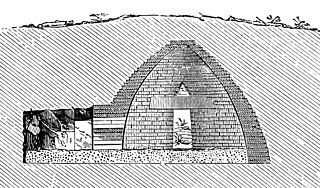
A beehive tomb, also known as a tholos tomb, is a burial structure characterized by its false dome created by corbelling, the superposition of successively smaller rings of mudbricks or, more often, stones. The resulting structure resembles a beehive, hence the traditional English name.

A kurgan is a type of tumulus constructed over a grave, often characterized by containing a single human body along with grave vessels, weapons and horses. Originally in use on the Pontic–Caspian steppe, kurgans spread into much of Central Asia and Eastern, Southeast, Western and Northern Europe during the 3rd millennium BC.

A tumulus is a mound of earth and stones raised over a grave or graves. Tumuli are also known as barrows, burial mounds or kurgans, and may be found throughout much of the world. A cairn, which is a mound of stones built for various purposes, may also originally have been a tumulus.

The Thracian Tomb of Kazanlak is a vaulted-brickwork "beehive" (tholos) tomb that is located near the town of Kazanlak in central Bulgaria.

Georgi Kitov was a Bulgarian archaeologist and thracologist. He specialized in Thracian archaeology. He participated in the excavations of many sites including the Alexandrovo Tomb, Kosmatka, Svetitzata and Starosel Cult Complex.
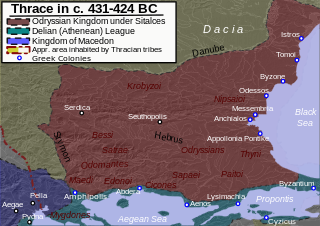
The Thracians were a group of Indo-European tribes inhabiting a large area in Central and Southeastern Europe, centred in modern Bulgaria. They were bordered by the Scythians to the north, the Celts and the Illyrians to the west, the Greeks to the south, and the Black Sea to the east.

Malagana, also known as the Malagana Treasure is an archaeological site of Colombia named after a sugarcane estate where it was accidentally discovered in 1992. During the few days after its discovery, the place was subject to a large scale looting with a rough estimate of 4 tons of pre-Columbian artifacts illegally removed from the burial mounds. A rescue archaeological mission was sent by the National Institute of Anthropology and History (ICANH), led by archaeologist Marianne Cardale de Schrimpff. Archaeological excavations at the site established a previously unknown cultural complex, designated as Malagana-Sonsoid, that dates between 300 BC to 300 AD.
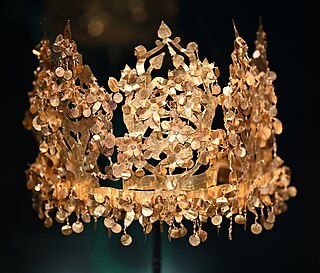
Tillya tepe, Tillia tepe or Tillā tapa is an archaeological site in the northern Afghanistan province of Jowzjan near Sheberghan, excavated in 1978 by a Soviet-Afghan team led by the Soviet archaeologist Viktor Sarianidi. The hoard found there is often known as the Bactrian gold.
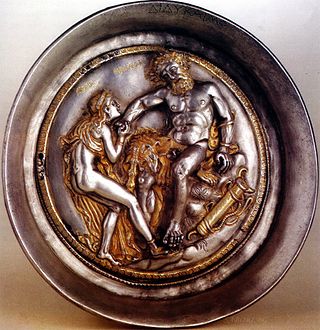
The Rogozen Treasure, called the find of the century, is a Thracian treasure.

Seuthes III was a king of Odrysia, a part of Thrace, during the late 4th century BC.

Menhet, Menwi and Merti, also spelled Manhata, Manuwai and Maruta, were three minor foreign-born wives of Pharaoh Thutmose III of the Eighteenth Dynasty. They are known for their lavishly furnished rock-cut tomb in Wady Gabbanat el-Qurud near Luxor, Egypt. They are suggested to be Syrian, as the names all fit into Canaanite name forms, although their ultimate origin is unknown. A West Semitic origin is likely, but both West Semitic and Hurrian derivations have been suggested for Menwi. Each of the wives bear the title of "king's wife", and were likely only minor members of the royal harem. It is not known if the women were related as the faces on the lids of their canopic jars are all different.

The Aleksandrovo tomb is a Thracian burial mound and tomb excavated near Aleksandrovo, Haskovo Province, South-Eastern Bulgaria, dated to c. 4th century BCE.
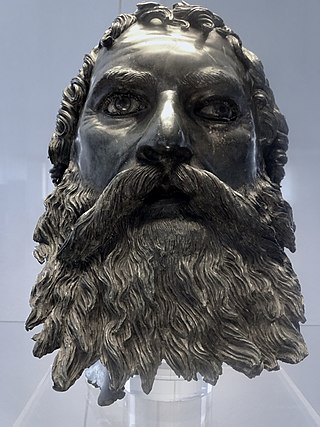
The Tomb of Seuthes III is located near Kazanlak, Bulgaria. Seuthes III was the King of the Odrysian Kingdom of Thrace from c. 331 to c. 300 BC and founder of the nearby Thracian city of Seuthopolis.

The Ostrusha mound is a Thracian burial tumulus near the Bulgarian town of Shipka. It was constructed in the middle of the 4th century BCE. The stone structures under the more than 18 meters high mound form one of the biggest representative tomb-cult complexes with 6 rooms on an area of 100 square meters. It was professionally excavated in 1993.

Golyama Arsenalka mound is a Thracian burial tumulus with a subterranean stone building near the Bulgarian town of Shipka. It dates from the end of 5th century BCE.

The Valley of the Thracian Rulers is a name which was made popular by the archaeologist Georgi Kitov and describes the extremely high concentration and variety of monuments of the Thracian culture in the Kazanlak Valley in Bulgaria. It is believed that there are over 1500 tumuli in the region, with only 300 being researched so far.

The gold wreaths from Thrace are jewellery wreaths found in inner Thrace, which is within present day Bulgaria. The gold wreaths were found in the mounds and tombs of aristocrats at various locations in Thrace that have been dated to a period from the latter half of the fourth century and early part third century BC.

The Watanuke Kannonyama Kofun (綿貫観音山古墳) is a Kofun period burial mound located in the Watanuki neighborhood of the city of Takasaki, Gunma Prefecture in the northern Kantō region of Japan. The site was designated a National Historic Site of Japan in 1973. The site dates from the late 6th Century, and many of the grave goods discovered during archaeological excavation were designated National Important Cultural Properties in 1994 In the year 2020, the collective status of 3346 artifacts from the tomb was raised to that of a National Treasure.
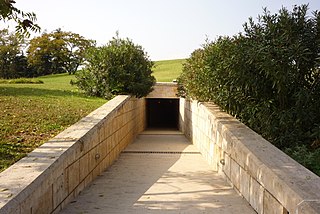
The Museum of the Royal Tombs of Aigai (Vergina) is located 75 km west of Thessaloniki, Greece, centered around the royal tombs built by the ancient Kingdom of Macedon at Aigai. The underground museum containing the burial cluster of Philip II of Macedon began construction in 1993 and was inaugurated in 1997. Exhibits are presented in four connected areas, including the Palace, the royal burial cluster of the Temenid dynasty (burial cluster "C"), the burial cluster of Philip II, and a gateway entrance with a semi-open-air exhibition of the sculptures found in the city sanctuaries and the restored upper floor of the Palace of Philip's facade. The tombs and other archaeological sites of Aigai were inscribed on the UNESCO World Heritage List in 1996 because of its exceptional architecture and testimony to the transition between city-states and empires in European civilization.





















